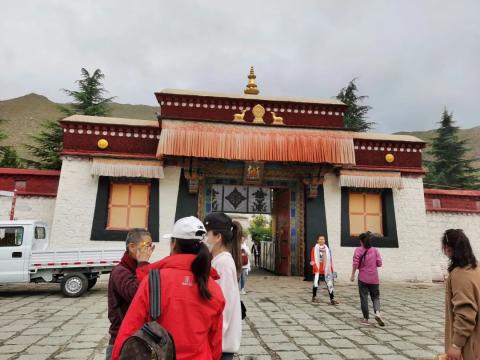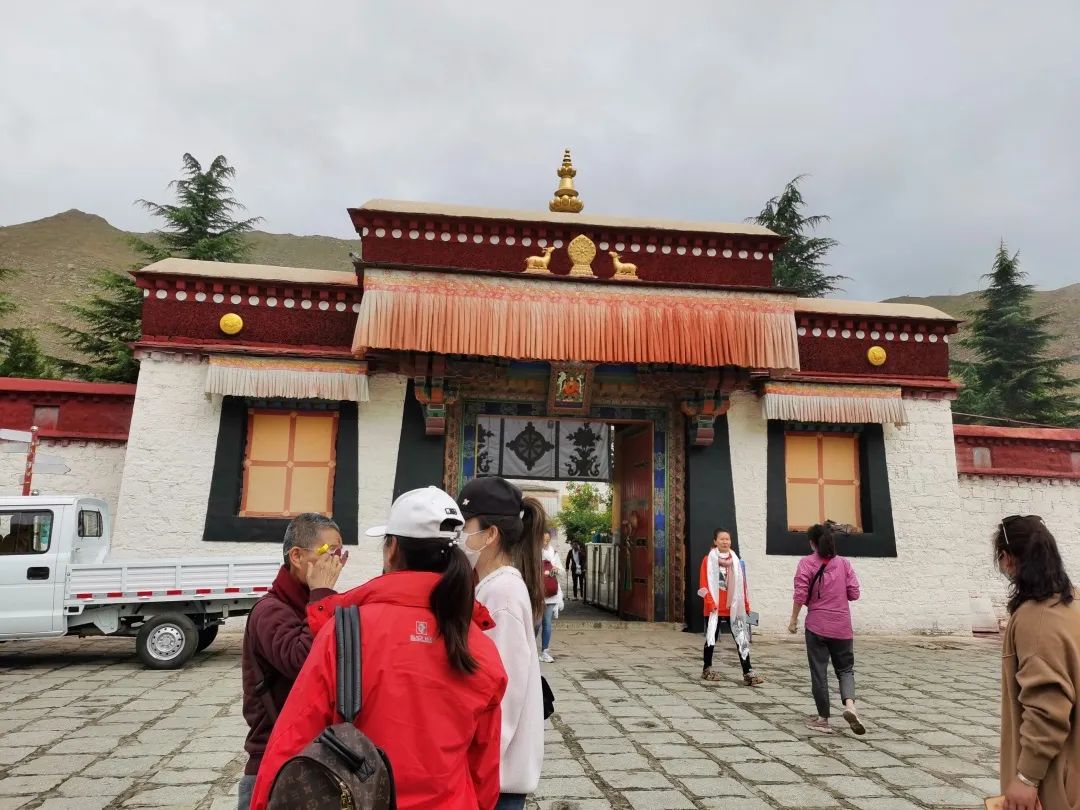
Dolma Lakhang
Dolma Lakhang was a complete surprise. We had not originally planned our trip to this temple. On the way back to Lhasa from Shigatse, Master Rinpoche suddenly mentioned that there was a nearby temple built in memory of Venerable Atisha. The temple also treasured the statue that guided the Venerable to come to Tibet to spread Buddhism. Talking Tara statue. So, the car relocated to Dolma Lakhang and drove away.
Venerable Atisha was not only a well-known scholar who had extensive knowledge of sutras and esoteric scriptures, but he was also a saint with full compassion, perfect internal realization, abbot of holy teachings, and benefiting all sentient beings. His benefit to Indian Buddhism and even Tibetan Buddhism is inestimable. The Venerable has practiced Tara all his life and has a deep connection with Tara. Tara has appeared many times to guide the Venerable to achieve enlightenment and achievement.


Once, when Venerable Atisha was stationed at the Nalanda Temple, a monk reported to Venerable Atisha: "There is a monk named Majelpa who has a jar of wine hidden in his room." The Venerable then scolded Majelba. Ba violated the precepts. Magheba explained: "This wine is used as an offering when practicing secret mantras. I have not violated the precepts." However, Venerable Atisha still ordered him to leave the temple, and Majerpa immediately walked out of the wall and left Nalanda Temple.
After seeing this, the Venerable became confused and prayed to the deity Tara for enlightenment. Tara predicted: "The monk you forced away is a Bodhisattva who ascended the earth. You have committed a serious crime that harmed the Bodhisattva. You have committed this crime." The unripe fruit of mortal sin will cause you to be reborn as a very large animal in your next life, and your flesh will be eaten by many birds." The Venerable also prayed to Tara: What method can purify these sins?

Tara said: "You can purify these sins by going to the north to promote Mahayana Buddhism and making forty-nine small clay stupas every day." This incident became the reason why Venerable Atisha later went to Tibet to promote Dharma.
Another time, Venerable Atisha was in Bodh Gaya, the holy place where the Buddha attained enlightenment. Tara, the Holy Saviour, and the Buddha, the Frowning Eyebrow Buddha, transformed into two solemn young women standing by the lotus pond to the south of the stupa. One of them asked Another asked: "What is the best way to practice to achieve complete enlightenment?" Another replied: "Selfless bodhicitta is the path to Buddhahood. How can one turn around and abandon others?"

The next day, His Holiness went around the stupa and the Bodhi tree next to it, under which Shakyamuni Buddha once meditated. The Venerable heard a beggar woman tell a leper: "Equal compassion and bodhicitta are the best ways to transcend the sea of suffering and achieve complete enlightenment. Put yourself in the shoes of others and give up selfish thoughts." "
His Holiness thought to himself: "Everyone here, from the noblest to the humblest, seems to know the best way to enlightenment, which is consistent with what my master said. Why am I alone and hesitant?"

Dolma Lakhang's
flowers

On the third day, Venerable Atisha slowly walked around the temple holding a rosary. He saw a little bird resting on the lap of the statue of Guanyin Bodhisattva. He heard the Buddha say to the little bird: "The bodhicitta of giving up oneself and loving others is The best way to achieve complete enlightenment is to prioritize others, take the credit for your victories and benefits, and accept your failures.”
At this moment, incredibly, Atisha found that all his doubts had vanished. After that, the Venerable went to Master Jinzhou to practice Bodhicitta for twelve years, and finally developed the sincere Bodhicitta.

Venerable Atisha's visit to Tibet to promote Buddhism is also inseparable from Tara's blessing. In order to promote Mahayana Buddhism in Tibet, the King of Tibet sent people to welcome Atisha to Tibet. The Venerable asked the Tara statue: "Can I benefit sentient beings if I go to Tibet? Can it fulfill the wish of the King of Tibet? Is there any obstacle to life span?" The Tara statue said: "If you go to Tibet, you will definitely benefit. All sentient beings, the King of Tibet will also be happy, because his only wish is to promote Mahayana Buddhism, but if you go to Tibet, you will live less than twenty years." After receiving Tara's prophecy, the Venerable resolutely went to Tibet to promote Buddhism. And at the age of 72, he passed away in what is now Nietang District, Qushui City. The venerable disciple Zhongdunpa built a temple here in memory of his master. The statue of Tara that the venerable carried with him during his lifetime is still enshrined in the temple. Therefore, the temple was named "Dolma Lakhang". "Dolma" means "Tara", and "Lakang" means the Buddhist temple.


The temple is right next to National Highway 318, and the transportation is very convenient. It is indeed a temple blessed by Tara. In the small courtyard, all kinds of flowers are vying for beauty and beauty. A senior fellow student and I were immediately lost in these flowers. The two of us were busy taking photos, but without noticing, the large group had disappeared. We hurried to catch up, and it turned out that everyone had already entered the main hall and were queuing up to wait for Tara's blessing! The master of the temple held a Tara statue in his hand and blessed everyone one by one. In the main hall, the monks lined up and were chanting sutras. Their voices were beautiful and melodious. The brothers hurriedly made offerings to each other. Walking out of the main hall of the temple, there is an ancient prayer wheel on the left hand side, with a copper bell hanging on it. Every time the prayer wheel turns around, the copper bell will make a crisp sound. This is something we haven't seen anywhere else. Next to the prayer wheel is an equally ancient Vajra pillar, protected by an iron fence. It is said that these are also precious magic weapons left by Venerable Atisha.

Outside the gate of the temple, there is a large smoke furnace, and a Tibetan adds smoke materials to the furnace. The smoke from the furnace fills the three thousand worlds. Smoke-giving stoves of this shape can be found in every monastery in Tibet. Even hotels and people's homes will place one in an open place to give food to hungry ghosts and living beings in the bardo. Tara is like our mother, caring for us and saving us. As students who follow Tara, we naturally have to care for and save all living beings. And smoke giving can very well save those living beings in the realm of hungry ghosts who have suffered from hunger and pain all their lives. We can make financial donations, Dharma donations, and fearless donations for them. We also hope that they can generate bodhicitta, supreme confidence in the Three Jewels, and be reborn in the West. Elysium. Smoke giving is also a convenient method for Mahayana practitioners to practice to benefit others.

